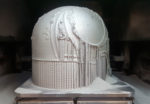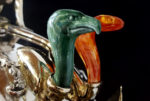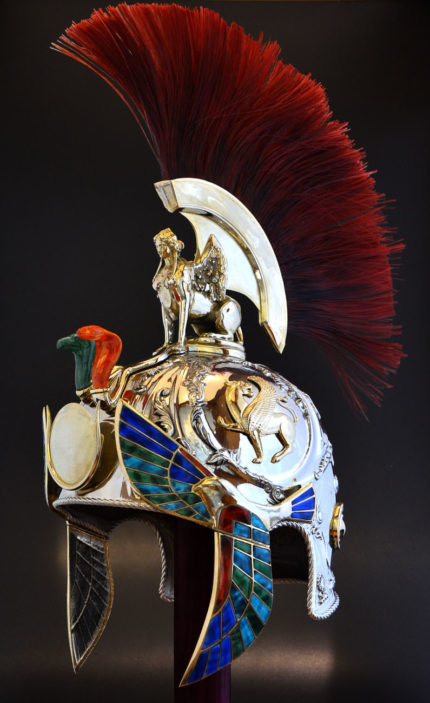 Custom Prototypes has created what can only be described as a masterpiece of historical recreation. It’s made of 3D-printed stainless steel and resin (aka stereolithography or SLA plastic), which sounds easy but is far, far from it. For one thing, steel doesn’t come out of the printer all shiny and pretty. The helmet started out as a dull plastic-looking affair requiring a bristling mass of supports in what would become the hollow part that needed to be removed before the finished product could look anything like the original.
Custom Prototypes has created what can only be described as a masterpiece of historical recreation. It’s made of 3D-printed stainless steel and resin (aka stereolithography or SLA plastic), which sounds easy but is far, far from it. For one thing, steel doesn’t come out of the printer all shiny and pretty. The helmet started out as a dull plastic-looking affair requiring a bristling mass of supports in what would become the hollow part that needed to be removed before the finished product could look anything like the original.
 Then all the individually printed stainless steel parts — helmet base, decorative elements — had to be sanded, polished and buffed to a high gloss. Once that was done, the resin pieces were printed in clear plastic, including the fantastic mohawk, and then painted and dyed to look like gemstones. That’s not an easy process either, making little plastic bits look like jade or lapis lazuli or feathers.
Then all the individually printed stainless steel parts — helmet base, decorative elements — had to be sanded, polished and buffed to a high gloss. Once that was done, the resin pieces were printed in clear plastic, including the fantastic mohawk, and then painted and dyed to look like gemstones. That’s not an easy process either, making little plastic bits look like jade or lapis lazuli or feathers.
 It helps to elevate the material when you electroplate the base, figures and reliefs with nickel, copper, chrome and just for good measure, 24 carat gold. Pieced all together the final work may bear zero relation to any actual Roman helmet that ever existed, but it sure looks spectacular.
It helps to elevate the material when you electroplate the base, figures and reliefs with nickel, copper, chrome and just for good measure, 24 carat gold. Pieced all together the final work may bear zero relation to any actual Roman helmet that ever existed, but it sure looks spectacular.

Most of all, it’s a testament to how much is possible with 3D printing technology and months of hard work. This video documents the fascinating process.
Etiam Latinitas huius rei dubia est: Ruscisilva sive urbs Aquifoliensis (Anglice “Hollywood”) est regio urbis Angelopolis Californiae propter industriam pellicularem nota atque quo multae mundi pelliculae hic unde. Ruscisilvae administratio praefectusque non dantur, sed Ruscisilvanum Corpus Mercatorum “magistrum honorarium”, qui est administrator sollemnis, eligit.
———-
PS: Yes, this thing is indeed “unbelievable”: The 3d printing is really cool (and here in particular beautifully executed), but I too seriously doubt that a helmet like that ever existed. There were obviously several designs (and a lazurite broom) ‘copied and pasted together’ – So to speak, a ‘Dies Viae Christopheri’ in Roman Egypt, in combination with some imported stuff from 18th century France and Medieval Sicily 😆
Are yes, the helmet for the small man with a large ego to polish. A fine job, though, good enough for Beau Brummell.
It looks as much Egyptian as it does Roman.
It’s certainly spectacular (and having just acquired a little 3D printer, I can appreciate the work that went into it), but I have a hard time believing that anybody ever wore that monstrosity. Unless maybe the high muckety-muck over Egypt in the Roman Empire wanted to look good when reviewing the troops?
According to the legend this helmet was comissioned by Cleopatra, crafted by egyptian smiths and offerded to Mark Antony during the festivities of Donations of Alexandria in the year 34BC.
In agreement with Jean @ Howling Frog. That thing is hideous. At least partly because electroplate gilding simply doesn’t look much like pre-electroplate fire-gilding (mercury gilding), which always has a softness, subtlety and warmth, whereas no matter what you do with it, electroplate is always harsh, cold and mirror-like.
One wonders what the item would have looked like if manufactured in the tradional manner, I suspect it would look a thousand times better and possibly taken much less time to make. It is deeply ugly. :ohnoes:
As a student of history I have to say that the Roman helmet that is pictured here probably never existed (as some of the other commenters have said already), but it makes me wonder that could we understand history better with such technology? For example could it be used to print accurate artifacts that have been lost in history?
The near history gives us plenty of examples what potential 3D printing has: In the year 2000 the first working kidney was produced with a 3D printer and it still works after being transplanted into a patient many years later. In 2010 the first car was produced by 3D printing techniques as well.
The possibilities of 3D printing are truly phenomenal and items like this prove that 3D printing might truly have historical purpose in the years to come. What I mean by this is the fact that there exists thousands of manuscripts that describe artifacts that are lost in great detail, but could be remade with the 3D printing technology if enough care and right materials were used.
Roman Helmet is a historical thing is helping in making. People want room helmet to keep it live longer so this is
Thanks for sharing this nice 3d printed helmet with us